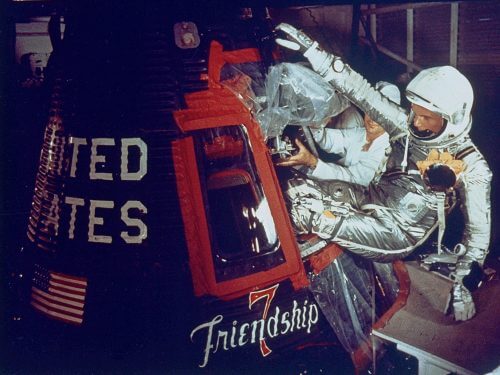During his flight in 1962 in the Friendship 7 spacecraft, he circled the Earth three times. At the end of the first lap, the automatic flight system broke and he had to operate the spacecraft manually for the next two laps and landing. The landing was also difficult when it turned out that the spacecraft's heat shield was loose, here too Glenn's resourcefulness helped

John Glenn, who was the first American astronaut to orbit the Earth, died today (Thursday) surrounded by his family members at Ohio University's Wexner Medical Center in Columbus, including his wife Annie Leah, to whom he was married for 73 years. Glenn's body will be placed in state at the Ohio Legislature and he will be buried in a private ceremony at Arlington National Cemetery near Washington.
As a Marine Corps pilot, Glenn broke the airspeed record before becoming the first American to orbit the Earth in 1962. 36 years later, at the age of 1998 in 77, he also became the oldest astronaut ever to fly into space, as part of the crew of the space shuttle Discovery. He made this flight in his 1998th and last year in the US Senate, and even tried to compete in the primary elections for the Democratic Party nomination for the US presidency in 24. About six months ago, on June 1984, the international airport in Columbus, Ohio was also named after him.
Glenn joined the Marine Corps Cadet Program in March 1942. He graduated and was commissioned in the Marines in 1943. After intensive training, he joined the 155th Fighter Squadron and flew F-4U fighter jets in the Marshall Islands for a year. He flew 59 combat missions during World War II.
After the war he served with Marine Squadron 218 on patrols over northern China and served in Guam. From June 1948 to December 1950 he served as an instructor at the Corps' Advanced Training Camp in Texas and then underwent amphibious combat training in Virginia.
In Korea, he flew 63 combat missions in the 311th Squadron of the Marine Corps and another 27 flights in F-86 Saber aircraft when he was loaned to the Air Force. In his last nine days of the Korean War, Glenn shot down three MiGs in combat over the Hyalu River.
The first and dangerous flight
After breaking the speed record as a test pilot, he joined NASA's first class of astronauts. – Mercury 7. Before his historic flight, he was the backup astronaut for Alan Shepard, the first American to take off into space, albeit for a much shorter flight on May 5, 1961, and for Gus Grissom, who flew after Shepard on his own suborbital flight. On February 20, 1962, Glenn took off from Cape Canaveral in a rickety capsule on the back of an Atlas rocket for America's New Front. It spent four hours 55 minutes and 23 seconds in orbit and completed three laps around the Earth.
When he watched the earth from a height of 150 km he said: "Oh, the view here is great". An operator in the NASA control room told him: "You are lucky." "Yes, you're right, it's very beautiful."
As mentioned, his first publication was when he circled the Earth in 1962 aboard the capsule Friendship 7. He was the one who returned to the USA the prestige it had lost when the Soviet Union led the early days of manned space flights.
A thirty-minute test to see if Glenn could fly the capsule manually became a matter of life and death when the automatic system broke down at the end of the first lap. "I switched to manual control and continued in this mode during the second and third laps and during the return to the atmosphere and the landing" Glenn recalled afterwards. He was confident in his ability to do so. "The accident forced me to prove quickly what I had planned for a long time."
Another problem seemed even more serious - the telemetry data showed that the heat shield was loose. It seems likely that Glenn and the spacecraft will burn up upon entering the atmosphere and most of the world will then hold its breath. Glenn activated a braking engine to stabilize the heat shield during atmospheric entry. "It was a spectacular entry into the atmosphere from where I was sitting." said. "Large pieces of burning material flew by the window. He wasn't sure if the burning fragments came from the deceleration missile or if the heat shield had disintegrated. "Fortunately" he said in an interview - it was from the missile. Otherwise I wouldn't be here to answer your questions."
Upon his return to Earth, he retired from NASA and served in the US Senate as a representative of the Democratic Party for 25 years. In 1998, Glenn took off on mission STS-95 on the space shuttle Discovery for a nine-day mission and assisted crew members in a variety of scientific studies, including launching the Spartan Solar Observatory. Glenn himself examined how the aging process is affected by being in space.
In 2011, Glenn received the Congressional Gold Medal - the highest civilian decoration in the USA. A year later, President Obama awarded him the Presidential Medal of Freedom. Following Glenn's death, Obama issued a statement: "John broke many records in his life, from defending our freedom as a fighter pilot in the Marines in World War II and in Korea, through breaking the speed record to becoming, at the age of 77, the oldest person to touch the stars.
NASA tweeted a short response - Godspeed, John Glenn. Ad astra"" to the stars in Latin.
For information on the NASA website
More of the topic in Hayadan:
